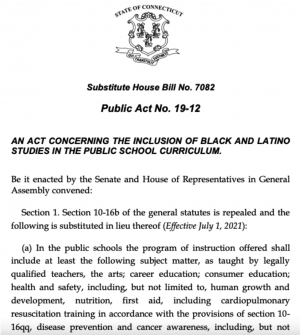African American, Black, Latino and Puerto Rican Studies must be a required course
Starting in the 2022-2023 school year, the state of Connecticut is mandating that all public high schools offer a course called African American, Black, Latino, and Puerto Rican Studies. But if there aren’t enough students to sign up for the class, students are not obligated to offer it. However, it is necessary that all students are required to take this class.
In my two and a half years as a student at Staples, almost every book I’ve been assigned has been written by a white male. The only historical events centered around Black Americans that I was taught was the Civil Rights Movement and slavery and I’ve yet to be taught anything about Latin American history or culture.
That being said, the true unicorn of my Staples experience was my Honors U.S. History class sophomore year. Aside from a quick unit during my freshman and sophomore English classes, U.S. History was the only class in which I learned beyond the typical white washed curriculum. I learned about topics ranging from implicit bias, to mass incarceration and more. We watched documentaries and read books about young Black Americans and the struggles they faced living in this country. However, that wasn’t enough.
The American education system is flawed in many ways, but the biggest shortcoming of this system is the whitewashing of history. Thankfully, at the end of 2020, Connecticut became the first state in the U.S. to mandate that all public high schools offer a course called African American, Black, Latino, and Puerto Rican Studies. This is a great stepping stone to make our education more diverse, however, it is necessary that this class is a mandatory course for all students.
It is important to note that the state simply requires that this course is offered in all high schools. The state does not mandate that all students must be enrolled in the course but rather that students are given the option to do so. Therefore, as with any other class at Staples, if there aren’t enough students that sign up, the class will not run.
It is crucial especially in states like Connecticut with a population that is 79.9% white, and towns like Westport which is 89.6% white that students are taught about other races, ethnicities and cultures. As many residents of Connecticut and Westport receive little exposure to non-white people, it is important that students receive an education of the culture and history of those who are different then themselves.
According to the United Nations Educational, Scientific and Cultural Organization, education is key in decreasing, and hopefully one day eliminating racism and discrimination. The organization claims that racism is not solely about skin color, but the intolerance of those who are physically or culturally different. It is crucial that our schools provide a diverse education and create an accepting environment in order to foster tolerance and understanding.
In a time of increasing hate crimes, a rise of political polarization, the root of all these issues is the absence of understanding of one another. Although one course can by no means solve racism, or obliterate discrimination, it is one way in which Connecticut students can gain a deeper understanding of people who are different than themselves. Now more than ever we must expand our education to reflect these evolving times.
I must also acknowledge that this course is not perfect. Its purpose is to educate students on the history, people and cultures that are often overlooked, yet it fails to recognize many other groups such as Native Americans and Asian Americans who are often forgotten in our education.
I hope that one day that the history and culture of these minority groups will be integrated with standard U.S. History courses in which students will not only learn about the oppressive history of many of these groups, but about real people and events that existed despite persecution. I hope students will read books by Latino authors, learn about Black artists, study Puerto Rican scientists and African American inventors. But for now, we still have a long way to go.




















































